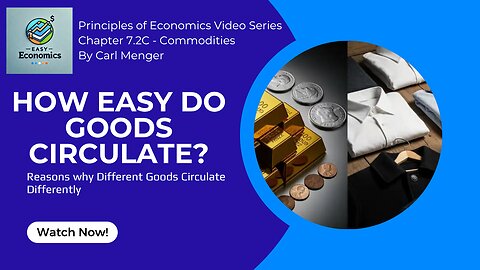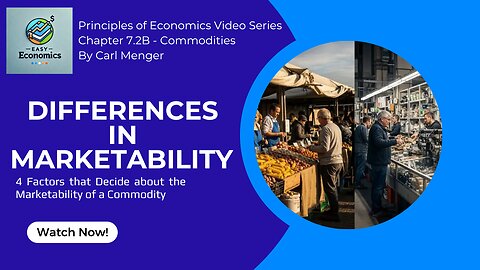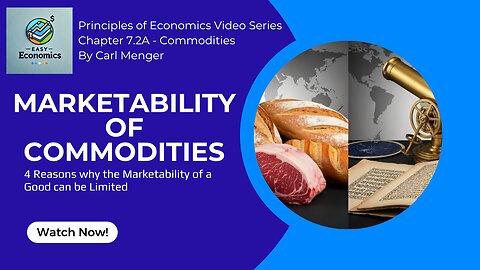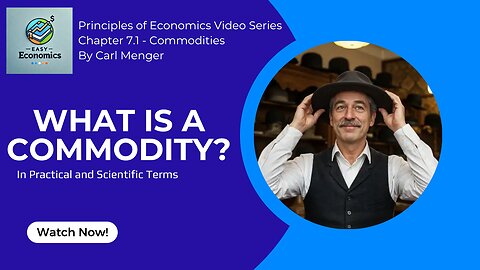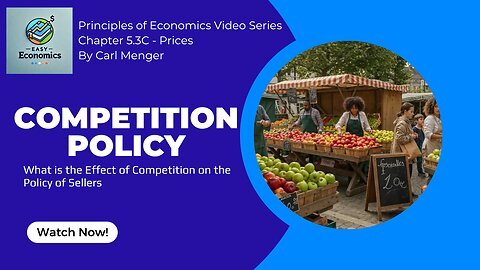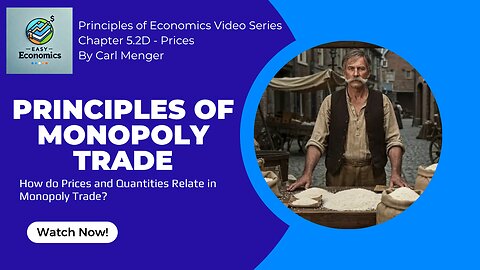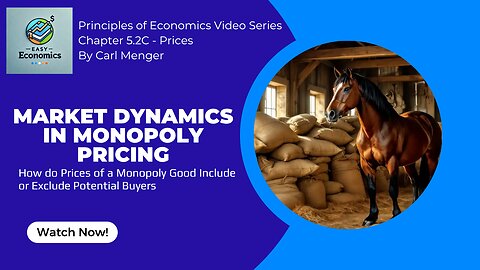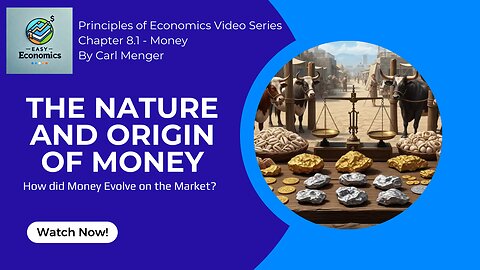
Principles of Economics by Carl Menger
37 videos
Updated 3 months ago
Welcome to our video series on Principles of Economics by Carl Menger — the book that started the Austrian School of Economics. First published in 1871, this groundbreaking work changed how we think about value, prices, and the decisions people make. Menger argued that value isn’t set by governments or production costs but by how useful something is to each person in a specific situation. This simple but powerful insight laid the foundation for modern economics.
In this playlist, we break down Menger’s ideas into short, easy-to-follow videos. You’ll learn what makes something a “good,” how human needs shape markets, and why individual choices matter more than big economic plans. We’ll also explain how his thinking differed from other economists of his time—and why his ideas are still relevant today.
Whether you’re a student, investor, or just curious about how economies really work, this series is made for you. No complex language, no long lectures—just clear explanations of the core ideas behind one of the most important economics books ever written. Start watching and discover how Principles of Economics changed economic thinking forever.
-
Principles of Economics by Carl Menger Chapter 8.1 - The Nature and Origin of Money
 EasyEconomicsYou want to read the book? Get it here: 👉 https://amzn.to/4exiAKW Watch the next video in this series: Coming Soon! Watch the video series from the start: https://rumble.com/playlists/I48mBTB4w2c Watch our video about Carl Menger: https://rumble.com/v61z0l2-carl-menger-the-father-of-austrian-economics-and-subjective-value.html Where did money come from—and who invented it? In this video, we explore Carl Menger’s Principles of Economics, Section 8.1: On the Nature and Origin of Money—a foundational explanation of how money emerged not by law, but through voluntary trade. Early economies relied on direct barter. But bartering only works when two people each want exactly what the other has—at the same time. This “double coincidence of wants” was rare and made trade inefficient. So how did economies evolve beyond this? Menger shows that people gradually realized they could accept goods not for their direct use, but because those goods were easier to trade. For example, a weaponsmith might accept cattle for his armor—not because he needed cattle, but because he knew others would. Over time, highly marketable goods like cattle, salt, or metal became stepping stones to what people really wanted. Eventually, this habit of accepting certain tradable goods became widespread. These goods—accepted everywhere, for anything—became money. Not because a government declared them money, but because the logic of trade and the habits of people made them money. Governments sometimes strengthened these goods by declaring them acceptable for taxes or debts. But that didn’t create money—it merely reinforced what the market had already chosen. In short: money is a product of human action, not state planning. It emerged naturally as individuals sought better ways to trade. ❓ Questions This Video Answers: -What is the true origin of money? -Why did barter limit early trade? -How did people solve the problem of double coincidence of wants? -What makes a good naturally evolve into money? -Did the state invent money? -Why were goods like cattle used as early money? -What role did habit play in the rise of money? -How does indirect exchange improve trade efficiency? -Can money exist without legal backing? -What does Menger’s theory say about modern money? 00:00 - Introduction to the Nature and Origin of Money 00:09 - The Limitations of Early Trade 01:07 - The Natural Solution to Trade Emerges 01:50 - The Weapon Smith Example 02:31 - The Birth of Money 03:02 - The Role of Habit and Imitation 03:33 - The State’s Limited Role in the Origin of Money 04:04 - Conclusion 04:34 - Outro #OriginOfMoney #CarlMenger #AustrianEconomics15 views
EasyEconomicsYou want to read the book? Get it here: 👉 https://amzn.to/4exiAKW Watch the next video in this series: Coming Soon! Watch the video series from the start: https://rumble.com/playlists/I48mBTB4w2c Watch our video about Carl Menger: https://rumble.com/v61z0l2-carl-menger-the-father-of-austrian-economics-and-subjective-value.html Where did money come from—and who invented it? In this video, we explore Carl Menger’s Principles of Economics, Section 8.1: On the Nature and Origin of Money—a foundational explanation of how money emerged not by law, but through voluntary trade. Early economies relied on direct barter. But bartering only works when two people each want exactly what the other has—at the same time. This “double coincidence of wants” was rare and made trade inefficient. So how did economies evolve beyond this? Menger shows that people gradually realized they could accept goods not for their direct use, but because those goods were easier to trade. For example, a weaponsmith might accept cattle for his armor—not because he needed cattle, but because he knew others would. Over time, highly marketable goods like cattle, salt, or metal became stepping stones to what people really wanted. Eventually, this habit of accepting certain tradable goods became widespread. These goods—accepted everywhere, for anything—became money. Not because a government declared them money, but because the logic of trade and the habits of people made them money. Governments sometimes strengthened these goods by declaring them acceptable for taxes or debts. But that didn’t create money—it merely reinforced what the market had already chosen. In short: money is a product of human action, not state planning. It emerged naturally as individuals sought better ways to trade. ❓ Questions This Video Answers: -What is the true origin of money? -Why did barter limit early trade? -How did people solve the problem of double coincidence of wants? -What makes a good naturally evolve into money? -Did the state invent money? -Why were goods like cattle used as early money? -What role did habit play in the rise of money? -How does indirect exchange improve trade efficiency? -Can money exist without legal backing? -What does Menger’s theory say about modern money? 00:00 - Introduction to the Nature and Origin of Money 00:09 - The Limitations of Early Trade 01:07 - The Natural Solution to Trade Emerges 01:50 - The Weapon Smith Example 02:31 - The Birth of Money 03:02 - The Role of Habit and Imitation 03:33 - The State’s Limited Role in the Origin of Money 04:04 - Conclusion 04:34 - Outro #OriginOfMoney #CarlMenger #AustrianEconomics15 views -
Principles of Economics by Carl Menger Chapter 7.2C - Circulability of Commodities
 EasyEconomicsYou want to read the book? Get it here: 👉 https://amzn.to/4exiAKW Watch the next video in this series: https://rumble.com/v6w0q4i-principles-of-economics-by-carl-menger-chapter-8.1-the-nature-and-origin-of.html Watch the video series from the start: https://rumble.com/playlists/I48mBTB4w2c Watch our video about Carl Menger: https://rumble.com/v61z0l2-carl-menger-the-father-of-austrian-economics-and-subjective-value.html Why do some goods circulate easily while others don’t—even if they’re valuable? In this video, we explore Carl Menger’s Principles of Economics, Section 7.2C: On the Circulability of Commodities. We’ve already seen what makes some commodities more marketable than others. But marketability isn’t the whole story. Menger now takes it further: to circulate well, a good must be resellable by anyone, anywhere, at any time—without losing value. Take gold: whether it’s held by a miner, trader, or investor, it keeps its value and sells easily. It’s highly circulable. But other goods—like food, used clothing, or personal items—may sell once but are hard to resell. Even if unused, fear of wear, spoilage, or mismatch kills their value in the next trade. Other limits include: Legal and technical barriers: Medicines, exports, or specialized tools require knowledge or permits to sell again. Customization: Items like shoes or hats need expert fitting, which most people can’t offer. Price uncertainty: Goods with unstable or hard-to-verify prices don’t move easily across hands. In contrast, goods like grain, metals, or securities circulate well because they are durable, standardized, in wide demand, and backed by public market pricing. Understanding circulability helps explain why some goods serve as money and others never can. It’s not just value that matters—it’s how easily and repeatedly a good can pass through hands without friction or loss. ❓ Questions This Video Answers: -What does “circulability” mean in economics? -Why do some valuable goods circulate poorly? -How is marketability different from circulability? -Why is gold highly circulable but food is not? -What role do legal or technical barriers play in resale? -How does price volatility affect resale potential? -What makes securities or grain ideal for repeated trade? -Why can’t custom goods circulate easily? -How does circulability relate to money? -What are the core qualities of a circulable good? 00:00 - Introduction to the Circulability of Commodities 00:12 - Circulability of Commodities 00:41 - Factors Affecting Circulation 01:38 - Specialized Goods and Price Stability 02:32 - Conclusion 03:25 - Outro #Circulability #ResaleEconomics #CarlMenger15 views
EasyEconomicsYou want to read the book? Get it here: 👉 https://amzn.to/4exiAKW Watch the next video in this series: https://rumble.com/v6w0q4i-principles-of-economics-by-carl-menger-chapter-8.1-the-nature-and-origin-of.html Watch the video series from the start: https://rumble.com/playlists/I48mBTB4w2c Watch our video about Carl Menger: https://rumble.com/v61z0l2-carl-menger-the-father-of-austrian-economics-and-subjective-value.html Why do some goods circulate easily while others don’t—even if they’re valuable? In this video, we explore Carl Menger’s Principles of Economics, Section 7.2C: On the Circulability of Commodities. We’ve already seen what makes some commodities more marketable than others. But marketability isn’t the whole story. Menger now takes it further: to circulate well, a good must be resellable by anyone, anywhere, at any time—without losing value. Take gold: whether it’s held by a miner, trader, or investor, it keeps its value and sells easily. It’s highly circulable. But other goods—like food, used clothing, or personal items—may sell once but are hard to resell. Even if unused, fear of wear, spoilage, or mismatch kills their value in the next trade. Other limits include: Legal and technical barriers: Medicines, exports, or specialized tools require knowledge or permits to sell again. Customization: Items like shoes or hats need expert fitting, which most people can’t offer. Price uncertainty: Goods with unstable or hard-to-verify prices don’t move easily across hands. In contrast, goods like grain, metals, or securities circulate well because they are durable, standardized, in wide demand, and backed by public market pricing. Understanding circulability helps explain why some goods serve as money and others never can. It’s not just value that matters—it’s how easily and repeatedly a good can pass through hands without friction or loss. ❓ Questions This Video Answers: -What does “circulability” mean in economics? -Why do some valuable goods circulate poorly? -How is marketability different from circulability? -Why is gold highly circulable but food is not? -What role do legal or technical barriers play in resale? -How does price volatility affect resale potential? -What makes securities or grain ideal for repeated trade? -Why can’t custom goods circulate easily? -How does circulability relate to money? -What are the core qualities of a circulable good? 00:00 - Introduction to the Circulability of Commodities 00:12 - Circulability of Commodities 00:41 - Factors Affecting Circulation 01:38 - Specialized Goods and Price Stability 02:32 - Conclusion 03:25 - Outro #Circulability #ResaleEconomics #CarlMenger15 views -
Principles of Economics by Carl Menger Chapter 7.2B - Differences in Marketability of Commodities
 EasyEconomicsYou want to read the book? Get it here: 👉 https://amzn.to/4exiAKW Watch the next video in this series: https://rumble.com/v6vipxb-principles-of-economics-by-carl-menger-chapter-7.2c-circulability-of-commod.html Watch the video series from the start: https://rumble.com/playlists/I48mBTB4w2c Watch our video about Carl Menger: https://rumble.com/v61z0l2-carl-menger-the-father-of-austrian-economics-and-subjective-value.html Why are some goods easy to sell and others a struggle to move? In this video, we explore Carl Menger’s Principles of Economics, Section 7.2B: On the Different Degrees of Marketability of Commodities. Marketability isn’t just about whether a good can be sold—it’s about how easily and reliably it can be sold at a fair price. Menger shows us that even within legal and physical trade limits, commodities differ greatly in their degrees of marketability. Key factors include: 1️⃣ Number of buyers – Goods like grain and metals have broad appeal, while rare instruments or niche books have few interested customers. 2️⃣ Location of markets – Some goods are tradable anywhere; others are tied to a few specific cities or regions. 3️⃣ Speculation – Highly marketable goods are often traded in anticipation of resale, like gold or wheat. 4️⃣ Timing – The more frequently a good can be sold (daily vs. annually), the more liquid and marketable it becomes. Goods with strong, organized markets—like grain, wool, or securities—are easier to sell because they’re backed by trading institutions, regular price listings, and active buyer networks. Less marketable goods, like decorative items or technical equipment, face unpredictable prices, limited buyers, and longer sales delays. Understanding these degrees of marketability is key to grasping why some goods function almost like money—and why others require time, effort, and luck to convert into value. ❓ Questions This Video Answers: -What is meant by "degree of marketability"? -Why do some goods sell faster and easier than others? -How do organized markets increase a good’s marketability? -What role does speculation play in trade? -How do time and location affect sales opportunities? -Why are niche products harder to sell? -What makes grain or gold "as good as cash"? -How do market reports and exchanges support trade? -What are examples of highly vs. poorly marketable goods? -How can sellers reduce the risk of unsold inventory? 00:00 - Introduction to Different Degrees of Marketability 00:11 - Internal and External Limits to Marketability 00:36 - Defining Commodities and Fair Pricing 01:29 - Organized Markets and Trading Centers 02:25 - Four Key Factors Affecting Marketability 03:38 - Practical Examples and Comparisons 04:51 - Outro #MarketabilityExplained #CommodityLiquidity #CarlMenger16 views
EasyEconomicsYou want to read the book? Get it here: 👉 https://amzn.to/4exiAKW Watch the next video in this series: https://rumble.com/v6vipxb-principles-of-economics-by-carl-menger-chapter-7.2c-circulability-of-commod.html Watch the video series from the start: https://rumble.com/playlists/I48mBTB4w2c Watch our video about Carl Menger: https://rumble.com/v61z0l2-carl-menger-the-father-of-austrian-economics-and-subjective-value.html Why are some goods easy to sell and others a struggle to move? In this video, we explore Carl Menger’s Principles of Economics, Section 7.2B: On the Different Degrees of Marketability of Commodities. Marketability isn’t just about whether a good can be sold—it’s about how easily and reliably it can be sold at a fair price. Menger shows us that even within legal and physical trade limits, commodities differ greatly in their degrees of marketability. Key factors include: 1️⃣ Number of buyers – Goods like grain and metals have broad appeal, while rare instruments or niche books have few interested customers. 2️⃣ Location of markets – Some goods are tradable anywhere; others are tied to a few specific cities or regions. 3️⃣ Speculation – Highly marketable goods are often traded in anticipation of resale, like gold or wheat. 4️⃣ Timing – The more frequently a good can be sold (daily vs. annually), the more liquid and marketable it becomes. Goods with strong, organized markets—like grain, wool, or securities—are easier to sell because they’re backed by trading institutions, regular price listings, and active buyer networks. Less marketable goods, like decorative items or technical equipment, face unpredictable prices, limited buyers, and longer sales delays. Understanding these degrees of marketability is key to grasping why some goods function almost like money—and why others require time, effort, and luck to convert into value. ❓ Questions This Video Answers: -What is meant by "degree of marketability"? -Why do some goods sell faster and easier than others? -How do organized markets increase a good’s marketability? -What role does speculation play in trade? -How do time and location affect sales opportunities? -Why are niche products harder to sell? -What makes grain or gold "as good as cash"? -How do market reports and exchanges support trade? -What are examples of highly vs. poorly marketable goods? -How can sellers reduce the risk of unsold inventory? 00:00 - Introduction to Different Degrees of Marketability 00:11 - Internal and External Limits to Marketability 00:36 - Defining Commodities and Fair Pricing 01:29 - Organized Markets and Trading Centers 02:25 - Four Key Factors Affecting Marketability 03:38 - Practical Examples and Comparisons 04:51 - Outro #MarketabilityExplained #CommodityLiquidity #CarlMenger16 views -
Principles of Economics by Carl Menger Chapter 7.2A - Marketability of Commodities
 EasyEconomicsYou want to read the book? Get it here: 👉 https://amzn.to/4exiAKW Watch the next video in this series: https://rumble.com/v6vgvk5-principles-of-economics-by-carl-menger-chapter-7.2b-differences-in-marketab.html Watch the video series from the start: https://rumble.com/playlists/I48mBTB4w2c Watch our video about Carl Menger: https://rumble.com/v61z0l2-carl-menger-the-father-of-austrian-economics-and-subjective-value.html Why are some goods easy to sell while others barely move at all? In this video, we explore Carl Menger’s Principles of Economics, Section 7.2A: On the Limits of Marketability of Commodities. While many economic theories focus on why goods are exchanged in certain quantities, Menger draws attention to something more practical: not all goods are equally marketable. That is, not all goods are equally easy to sell. And understanding this difference is essential—not just for producers and traders—but for grasping why money exists. Menger outlines four key limits that define a commodity’s marketability: 1️⃣ Buyer limitations: Not everyone can buy every good. Bread is easy to sell to anyone—rare tools or obscure books, not so much. 2️⃣ Geographic limits: Some goods (like steel or gold) can be shipped anywhere, while others (like manure or sand) are only profitable locally. 3️⃣ Quantity constraints: You can sell bread by the ton, but not everyone wants 1,000 Sanskrit textbooks. Some markets are naturally small. 4️⃣ Time sensitivity: Perishable or seasonal goods lose value fast. Others, like precious metals, hold their value over time. This analysis helps explain why some goods become money—they’re durable, portable, in demand, and easy to sell anytime, anywhere. Whether you’re a producer, investor, or just curious about how markets work, understanding these marketability factors is key to making better economic choices. ❓ Questions This Video Answers: -What does "marketability" mean in economics? -Why are some goods easier to sell than others? -How does geography limit trade? -What role does time play in a product’s marketability? -Why are some goods only profitable in certain regions? -How does quantity affect how easily something can be sold? -What kinds of goods are most durable in value over time? -Why is understanding marketability essential for economic planning? -What makes a good ideal for use as money? -How do perishable vs. non-perishable goods compare in trade? 00:00 - Introduction to Marketability Limits 00:11 - Marketability of Goods 00:45 - The Four Limits of Marketability 01:59 - Quantity and Time Constraints 03:22 - Conclusion 03:38 - Outro #Marketability #CommodityTrade #CarlMenger30 views 1 comment
EasyEconomicsYou want to read the book? Get it here: 👉 https://amzn.to/4exiAKW Watch the next video in this series: https://rumble.com/v6vgvk5-principles-of-economics-by-carl-menger-chapter-7.2b-differences-in-marketab.html Watch the video series from the start: https://rumble.com/playlists/I48mBTB4w2c Watch our video about Carl Menger: https://rumble.com/v61z0l2-carl-menger-the-father-of-austrian-economics-and-subjective-value.html Why are some goods easy to sell while others barely move at all? In this video, we explore Carl Menger’s Principles of Economics, Section 7.2A: On the Limits of Marketability of Commodities. While many economic theories focus on why goods are exchanged in certain quantities, Menger draws attention to something more practical: not all goods are equally marketable. That is, not all goods are equally easy to sell. And understanding this difference is essential—not just for producers and traders—but for grasping why money exists. Menger outlines four key limits that define a commodity’s marketability: 1️⃣ Buyer limitations: Not everyone can buy every good. Bread is easy to sell to anyone—rare tools or obscure books, not so much. 2️⃣ Geographic limits: Some goods (like steel or gold) can be shipped anywhere, while others (like manure or sand) are only profitable locally. 3️⃣ Quantity constraints: You can sell bread by the ton, but not everyone wants 1,000 Sanskrit textbooks. Some markets are naturally small. 4️⃣ Time sensitivity: Perishable or seasonal goods lose value fast. Others, like precious metals, hold their value over time. This analysis helps explain why some goods become money—they’re durable, portable, in demand, and easy to sell anytime, anywhere. Whether you’re a producer, investor, or just curious about how markets work, understanding these marketability factors is key to making better economic choices. ❓ Questions This Video Answers: -What does "marketability" mean in economics? -Why are some goods easier to sell than others? -How does geography limit trade? -What role does time play in a product’s marketability? -Why are some goods only profitable in certain regions? -How does quantity affect how easily something can be sold? -What kinds of goods are most durable in value over time? -Why is understanding marketability essential for economic planning? -What makes a good ideal for use as money? -How do perishable vs. non-perishable goods compare in trade? 00:00 - Introduction to Marketability Limits 00:11 - Marketability of Goods 00:45 - The Four Limits of Marketability 01:59 - Quantity and Time Constraints 03:22 - Conclusion 03:38 - Outro #Marketability #CommodityTrade #CarlMenger30 views 1 comment -
Principles of Economics by Carl Menger Chapter 7.1 - What is a Commodity?
 EasyEconomicsYou want to read the book? Get it here: 👉 https://amzn.to/4exiAKW Watch the next video in this series: https://rumble.com/v6v20er-principles-of-economics-by-carl-menger-chapter-7.2a-marketability-of-commod.html Watch the video series from the start: https://rumble.com/playlists/I48mBTB4w2c Watch our video about Carl Menger: https://rumble.com/v61z0l2-carl-menger-the-father-of-austrian-economics-and-subjective-value.html What is a commodity, really? In this video, we explore Carl Menger’s Principles of Economics, Section 7.1: The Concept of the Commodity in Popular and Scientific Terms. In early, self-sufficient economies, families produced everything for themselves. Goods weren’t traded—they were used directly. But economic development begins when people start offering their labor and products in exchange for others. This leads from home-based production to workshops, and eventually to mass production and ready-made goods. In daily language, “commodity” usually refers to movable, physical goods made for sale. But Menger explains that in economics, a commodity is not defined by what the good is—but by how the owner treats it. A good becomes a commodity only when it’s intended for exchange. Once it’s kept for personal use, it ceases to be a commodity—even if it’s the exact same object. This concept reveals a deeper truth: being a commodity is not a permanent trait. It’s a temporary status, tied to a good’s place in the exchange process. A hat in a shop is a commodity; that same hat, once worn, becomes a consumer good. Even precious metals lose their commodity status if melted for private use. Menger’s insight clarifies why ownership intentions matter in economics—and helps distinguish between goods in circulation and goods in use. Understanding this shift is key to grasping the flow of value through an economy. ❓ Questions This Video Answers: -What is a commodity in economics? -How does a good become a commodity? -Can a commodity lose its status? -What role does ownership intention play in defining commodities? -How did early economies evolve into trade economies? -What’s the difference between popular and scientific definitions of commodities? -Why does a consumer good differ from a commodity? -How do mass production and trade change how we value goods? -What’s the lifecycle of a commodity in the market? -Can the same item shift between commodity and consumer good? 00:00 - Introduction to What is a Commodity 00:11 - Goods in a Self-Sufficient Economy 00:52 - The Evolution of Economic Systems 02:05 - Defining Commodities: Popular VS scientific Terms 03:01 - Practical Examples 03:52 - Outro #CommoditiesExplained #EconomicGoods #CarlMenger11 views 1 comment
EasyEconomicsYou want to read the book? Get it here: 👉 https://amzn.to/4exiAKW Watch the next video in this series: https://rumble.com/v6v20er-principles-of-economics-by-carl-menger-chapter-7.2a-marketability-of-commod.html Watch the video series from the start: https://rumble.com/playlists/I48mBTB4w2c Watch our video about Carl Menger: https://rumble.com/v61z0l2-carl-menger-the-father-of-austrian-economics-and-subjective-value.html What is a commodity, really? In this video, we explore Carl Menger’s Principles of Economics, Section 7.1: The Concept of the Commodity in Popular and Scientific Terms. In early, self-sufficient economies, families produced everything for themselves. Goods weren’t traded—they were used directly. But economic development begins when people start offering their labor and products in exchange for others. This leads from home-based production to workshops, and eventually to mass production and ready-made goods. In daily language, “commodity” usually refers to movable, physical goods made for sale. But Menger explains that in economics, a commodity is not defined by what the good is—but by how the owner treats it. A good becomes a commodity only when it’s intended for exchange. Once it’s kept for personal use, it ceases to be a commodity—even if it’s the exact same object. This concept reveals a deeper truth: being a commodity is not a permanent trait. It’s a temporary status, tied to a good’s place in the exchange process. A hat in a shop is a commodity; that same hat, once worn, becomes a consumer good. Even precious metals lose their commodity status if melted for private use. Menger’s insight clarifies why ownership intentions matter in economics—and helps distinguish between goods in circulation and goods in use. Understanding this shift is key to grasping the flow of value through an economy. ❓ Questions This Video Answers: -What is a commodity in economics? -How does a good become a commodity? -Can a commodity lose its status? -What role does ownership intention play in defining commodities? -How did early economies evolve into trade economies? -What’s the difference between popular and scientific definitions of commodities? -Why does a consumer good differ from a commodity? -How do mass production and trade change how we value goods? -What’s the lifecycle of a commodity in the market? -Can the same item shift between commodity and consumer good? 00:00 - Introduction to What is a Commodity 00:11 - Goods in a Self-Sufficient Economy 00:52 - The Evolution of Economic Systems 02:05 - Defining Commodities: Popular VS scientific Terms 03:01 - Practical Examples 03:52 - Outro #CommoditiesExplained #EconomicGoods #CarlMenger11 views 1 comment -
Principles of Economics by Carl Menger Chapter 5.3C - Competition Policy
 EasyEconomicsYou want to read the book? Get it here: https://amzn.to/4cCPIQs Watch the next video in this series: https://rumble.com/v6ut1r3-principles-of-economics-by-carl-menger-chapter-6a-use-value-and-exchange-va.html Watch the video series from the start: https://rumble.com/playlists/I48mBTB4w2c Watch our video about Carl Menger: https://rumble.com/v61z0l2-carl-menger-the-father-of-austrian-economics-and-subjective-value.html What does competition really change in a market? In this video, we explore Carl Menger’s Principles of Economics, Section 5.3C: The Effect of Competition on Prices and Supply. At first glance, it might seem like it doesn’t matter whether one seller or many offer a product—if the total supply and price stay the same, so will the outcome. But Menger shows that true competition changes everything. When a monopolist controls the market, they can restrict supply to raise prices, or sell to different social groups at different prices to maximize profits. But the moment real competitors enter the scene—each acting independently—those tactics fall apart. A competitor who tries to destroy part of their stock to push prices up will simply lose market share to others. And sellers who aim only at wealthy buyers get undercut by competitors selling to the masses. As a result, prices fall, access expands, and wasteful practices vanish. More importantly, competition increases overall production. Where monopolists hold back output, multiple competing sellers flood the market, making goods more available to all. It pushes producers to serve more people, cut costs, and innovate. In short, Menger explains that competition doesn’t just affect prices—it transforms market structure, boosts efficiency, and spreads prosperity. This section offers a timeless defense of why free markets matter—and how competition ensures economic goods reach the widest number of people. ❓ Questions This Video Answers: -How does competition affect market prices? -Why can’t sellers destroy supply in competitive markets? -What happens when monopolies try to segment buyers? -How does competition change production levels? -Why does competition expand access to goods? -What role do incentives play under competition? -Why do prices drop in competitive markets? -How does competition increase efficiency? -What business practices disappear with strong competition? -Why is competition key to reaching lower-income buyers? 00:00 - Introduction to Competition Policy 00:12 - Competition vs Monopoly—Setting the Stage 00:54 - When Competition Actually Matters 01:36 - Competition Prevents Withholding and Manipulation 02:31 - Eliminating Harmful Monopoly Practices 02:56 - The Broader Benefits of Competition 03:50 - Motivation, Efficiency, and Social Reach 04:26 - Conclusion #FreeMarkets #CompetitionMatters #CarlMenger12 views
EasyEconomicsYou want to read the book? Get it here: https://amzn.to/4cCPIQs Watch the next video in this series: https://rumble.com/v6ut1r3-principles-of-economics-by-carl-menger-chapter-6a-use-value-and-exchange-va.html Watch the video series from the start: https://rumble.com/playlists/I48mBTB4w2c Watch our video about Carl Menger: https://rumble.com/v61z0l2-carl-menger-the-father-of-austrian-economics-and-subjective-value.html What does competition really change in a market? In this video, we explore Carl Menger’s Principles of Economics, Section 5.3C: The Effect of Competition on Prices and Supply. At first glance, it might seem like it doesn’t matter whether one seller or many offer a product—if the total supply and price stay the same, so will the outcome. But Menger shows that true competition changes everything. When a monopolist controls the market, they can restrict supply to raise prices, or sell to different social groups at different prices to maximize profits. But the moment real competitors enter the scene—each acting independently—those tactics fall apart. A competitor who tries to destroy part of their stock to push prices up will simply lose market share to others. And sellers who aim only at wealthy buyers get undercut by competitors selling to the masses. As a result, prices fall, access expands, and wasteful practices vanish. More importantly, competition increases overall production. Where monopolists hold back output, multiple competing sellers flood the market, making goods more available to all. It pushes producers to serve more people, cut costs, and innovate. In short, Menger explains that competition doesn’t just affect prices—it transforms market structure, boosts efficiency, and spreads prosperity. This section offers a timeless defense of why free markets matter—and how competition ensures economic goods reach the widest number of people. ❓ Questions This Video Answers: -How does competition affect market prices? -Why can’t sellers destroy supply in competitive markets? -What happens when monopolies try to segment buyers? -How does competition change production levels? -Why does competition expand access to goods? -What role do incentives play under competition? -Why do prices drop in competitive markets? -How does competition increase efficiency? -What business practices disappear with strong competition? -Why is competition key to reaching lower-income buyers? 00:00 - Introduction to Competition Policy 00:12 - Competition vs Monopoly—Setting the Stage 00:54 - When Competition Actually Matters 01:36 - Competition Prevents Withholding and Manipulation 02:31 - Eliminating Harmful Monopoly Practices 02:56 - The Broader Benefits of Competition 03:50 - Motivation, Efficiency, and Social Reach 04:26 - Conclusion #FreeMarkets #CompetitionMatters #CarlMenger12 views -
Principles of Economics by Carl Menger Chapter 5.3B - Price Formation by Competing Sellers
 EasyEconomicsYou want to read the book? Get it here: https://amzn.to/4cCPIQs Watch the next video in this series: https://rumble.com/v6unurp-principles-of-economics-by-carl-menger-chapter-5.3c-competition-policy.html Watch the video series from the start: https://rumble.com/playlists/I48mBTB4w2c Watch our video about Carl Menger: https://rumble.com/v61z0l2-carl-menger-the-father-of-austrian-economics-and-subjective-value.html What really determines the final price of goods in a market—the number of sellers or the quantity offered? In this video, we break down Carl Menger’s Principles of Economics, Section 5.3B: The Effect of Offered Quantities and Fixed Prices on Market Outcomes. Using the familiar example of farmers trading grain for horses, Menger shows how both monopoly and competitive markets follow the same core rules: the final price and distribution of goods depend not on how many sellers there are, but on how much of the good is available and the price being asked. If multiple sellers offer more horses, prices fall and more buyers can participate. If fewer horses are offered, prices rise and only top buyers can afford them. This matches what happens in a monopoly market where only one seller exists. In both cases, what matters is the total quantity and the buyers’ willingness to pay—not whether there’s one supplier or many. Likewise, when prices are fixed instead of negotiated, the same principle holds: higher prices reduce total sales and exclude more buyers; lower prices increase both. Again, it doesn’t matter if one or many sellers set the price—the outcome is the same. This chapter shows that competition doesn’t override basic economic laws. Whether in a monopoly or a crowded market, supply quantity and price levels are what determine the real economic results. ❓ Questions This Video Answers: -What determines the final price in a competitive market? -Do more sellers automatically lower prices? -How does the total quantity offered affect buyers? -Does competition change how goods are distributed? -What happens when prices are fixed? -Do fixed prices behave differently under monopoly or competition? -Why is buyer willingness to pay important? -How are goods shared among buyers when supply increases? -Is the number of sellers or total supply more important? -Do monopoly and competition follow the same pricing rules? 00:00 - Introduction into Competing Sellers and Price Formation 00:19 - Multiple Sellers and Price Impact 00:49 - Two Sellers Example 01:26 - Comparison with Monopoly 01:49 - Fixed Prices Scenario 02:13 - Summary of Principles 02:36 - Outro #PriceFormation #SupplyAndDemand #CarlMenger13 views
EasyEconomicsYou want to read the book? Get it here: https://amzn.to/4cCPIQs Watch the next video in this series: https://rumble.com/v6unurp-principles-of-economics-by-carl-menger-chapter-5.3c-competition-policy.html Watch the video series from the start: https://rumble.com/playlists/I48mBTB4w2c Watch our video about Carl Menger: https://rumble.com/v61z0l2-carl-menger-the-father-of-austrian-economics-and-subjective-value.html What really determines the final price of goods in a market—the number of sellers or the quantity offered? In this video, we break down Carl Menger’s Principles of Economics, Section 5.3B: The Effect of Offered Quantities and Fixed Prices on Market Outcomes. Using the familiar example of farmers trading grain for horses, Menger shows how both monopoly and competitive markets follow the same core rules: the final price and distribution of goods depend not on how many sellers there are, but on how much of the good is available and the price being asked. If multiple sellers offer more horses, prices fall and more buyers can participate. If fewer horses are offered, prices rise and only top buyers can afford them. This matches what happens in a monopoly market where only one seller exists. In both cases, what matters is the total quantity and the buyers’ willingness to pay—not whether there’s one supplier or many. Likewise, when prices are fixed instead of negotiated, the same principle holds: higher prices reduce total sales and exclude more buyers; lower prices increase both. Again, it doesn’t matter if one or many sellers set the price—the outcome is the same. This chapter shows that competition doesn’t override basic economic laws. Whether in a monopoly or a crowded market, supply quantity and price levels are what determine the real economic results. ❓ Questions This Video Answers: -What determines the final price in a competitive market? -Do more sellers automatically lower prices? -How does the total quantity offered affect buyers? -Does competition change how goods are distributed? -What happens when prices are fixed? -Do fixed prices behave differently under monopoly or competition? -Why is buyer willingness to pay important? -How are goods shared among buyers when supply increases? -Is the number of sellers or total supply more important? -Do monopoly and competition follow the same pricing rules? 00:00 - Introduction into Competing Sellers and Price Formation 00:19 - Multiple Sellers and Price Impact 00:49 - Two Sellers Example 01:26 - Comparison with Monopoly 01:49 - Fixed Prices Scenario 02:13 - Summary of Principles 02:36 - Outro #PriceFormation #SupplyAndDemand #CarlMenger13 views -
Principles of Economics by Carl Menger Chapter 5.3A - Price Forming and Distribution by Competition
 EasyEconomicsYou want to read the book? Get it here: https://amzn.to/4cCPIQs Watch the next video in this series: https://rumble.com/v6uke8j-principles-of-economics-by-carl-menger-chapter-5.3b-price-formation-by-comp.html Watch the video series from the start: https://rumble.com/playlists/I48mBTB4w2c Watch our video about Carl Menger: https://rumble.com/v61z0l2-carl-menger-the-father-of-austrian-economics-and-subjective-value.html How does competition emerge from monopoly—and how does it reshape prices and the distribution of goods? In this video, we explore Carl Menger’s Principles of Economics, Section 3A: Price Formation and Distribution of Goods under Mutual Competition. Monopolies aren’t just legal privileges. Menger explains that they can arise naturally—a doctor, craftsman, or merchant may become a monopolist simply by being the only provider of certain goods or services in a town. In fact, natural monopolies are older than competition itself! As economies grow—population increases, wealth rises, and demand expands—natural monopolists may react by raising prices and serving only the wealthiest clients, leaving others underserved. Over time, this creates an economic imbalance and resentment, especially when the monopolist can’t or won’t increase supply to match demand. But here’s the key insight: this very imbalance creates the conditions for competition. As long as no legal or social barriers exist, new providers will enter the market, breaking the monopoly. When competition arrives, it transforms everything: ✅ Prices become more stable and fair ✅ Goods and services reach broader parts of the population ✅ The monopolist must adapt or lose market share In this video, we’ll see how competition evolves naturally from monopoly, and why it plays such a crucial role in shaping healthy, dynamic markets. ❓ Questions This Video Answers: -What is a natural monopoly? -How can a monopoly arise without government privilege? -Why do monopolists raise prices as demand grows? -What happens when a monopolist can’t meet increasing demand? -How does competition emerge from monopoly? -How does competition affect prices? -How does competition change the distribution of goods? -Why is competition essential for dynamic markets? -What are historical examples of natural monopolies? -How does mutual competition improve market fairness? 00:00 - Introduction to price formation and distribution of goods under mutual competition 00:13 - The Concept of a Monopolist 00:46 - Historical Perspective on Monopoly 01:12 - Transition from Monopoly to Competition 01:58 - The Emergence of Competition 02:18 - Outro #MarketCompetition #PriceFormation #CarlMenger11 views
EasyEconomicsYou want to read the book? Get it here: https://amzn.to/4cCPIQs Watch the next video in this series: https://rumble.com/v6uke8j-principles-of-economics-by-carl-menger-chapter-5.3b-price-formation-by-comp.html Watch the video series from the start: https://rumble.com/playlists/I48mBTB4w2c Watch our video about Carl Menger: https://rumble.com/v61z0l2-carl-menger-the-father-of-austrian-economics-and-subjective-value.html How does competition emerge from monopoly—and how does it reshape prices and the distribution of goods? In this video, we explore Carl Menger’s Principles of Economics, Section 3A: Price Formation and Distribution of Goods under Mutual Competition. Monopolies aren’t just legal privileges. Menger explains that they can arise naturally—a doctor, craftsman, or merchant may become a monopolist simply by being the only provider of certain goods or services in a town. In fact, natural monopolies are older than competition itself! As economies grow—population increases, wealth rises, and demand expands—natural monopolists may react by raising prices and serving only the wealthiest clients, leaving others underserved. Over time, this creates an economic imbalance and resentment, especially when the monopolist can’t or won’t increase supply to match demand. But here’s the key insight: this very imbalance creates the conditions for competition. As long as no legal or social barriers exist, new providers will enter the market, breaking the monopoly. When competition arrives, it transforms everything: ✅ Prices become more stable and fair ✅ Goods and services reach broader parts of the population ✅ The monopolist must adapt or lose market share In this video, we’ll see how competition evolves naturally from monopoly, and why it plays such a crucial role in shaping healthy, dynamic markets. ❓ Questions This Video Answers: -What is a natural monopoly? -How can a monopoly arise without government privilege? -Why do monopolists raise prices as demand grows? -What happens when a monopolist can’t meet increasing demand? -How does competition emerge from monopoly? -How does competition affect prices? -How does competition change the distribution of goods? -Why is competition essential for dynamic markets? -What are historical examples of natural monopolies? -How does mutual competition improve market fairness? 00:00 - Introduction to price formation and distribution of goods under mutual competition 00:13 - The Concept of a Monopolist 00:46 - Historical Perspective on Monopoly 01:12 - Transition from Monopoly to Competition 01:58 - The Emergence of Competition 02:18 - Outro #MarketCompetition #PriceFormation #CarlMenger11 views -
Principles of Economics by Carl Menger Chapter 5.2D - Principles of Monopoly Trade
 EasyEconomicsYou want to read the book? Get it here: https://amzn.to/4cCPIQs Watch the next video in this series: https://rumble.com/v6uif73-principles-of-economics-by-carl-menger-chapter-5.3a-price-forming-and-distr.html Watch the video series from the start: https://rumble.com/playlists/I48mBTB4w2c Watch our video about Carl Menger: https://rumble.com/v61z0l2-carl-menger-the-father-of-austrian-economics-and-subjective-value.html How do monopolists strategically set prices and control supply to maximize profits? In this video, we dive into Carl Menger’s Principles of Economics, Chapter 5.2D: The Principles of Monopoly Trade (Monopolist Strategy). Monopolists may seem all-powerful, but they still face clear economic limits. They can’t simply set any price and expect unlimited sales. Trade, even monopoly trade, must still benefit both sides—buyers must see value in the deal. Menger explains that a monopolist can control either: ✅ The quantity of goods offered OR ✅ The price per unit— but not both at once. If they want to sell more, they must lower the price. If they want to maintain a high price, they must limit how much they sell. A clever monopolist seeks to maximize total revenue—not sales volume or market fairness. That’s why they might: 🔸 Sell first to wealthy buyers at high prices 🔸 Lower prices later to reach new markets 🔸 Even destroy supply to prevent price drops—just as the Dutch East India Company once did with spices. This behavior follows strict economic laws, not greed or randomness. History shows that when monopolists lose the ability to control supply (like after industrialization), their influence fades. In short: Monopoly pricing is a careful balancing act. The goal is simple—maximum profit. Menger’s insights still explain real-world markets today. ❓ Questions This Video Answers: -How do monopolists decide between controlling price or quantity? -Why can’t a monopolist control both price and quantity at once? -What is the goal of a monopolist’s strategy? -Why do monopolists sometimes limit supply on purpose? -How does monopoly trade still follow economic laws? -What is the impact of lowering prices on total revenue? -Why do monopolists target wealthier buyers first? -What historical examples show monopolist behavior? -What happens when monopolists lose control over supply? -Why is maximizing sales volume not always optimal? 00:00 - Introduction to the Principles of Monopoly Trade 00:12 - How Monopolists Influence Trade 01:48 - Lessons from History and Economic Laws 02:46 - Outro #MonopolyStrategy #ProfitMaximization #CarlMenger23 views
EasyEconomicsYou want to read the book? Get it here: https://amzn.to/4cCPIQs Watch the next video in this series: https://rumble.com/v6uif73-principles-of-economics-by-carl-menger-chapter-5.3a-price-forming-and-distr.html Watch the video series from the start: https://rumble.com/playlists/I48mBTB4w2c Watch our video about Carl Menger: https://rumble.com/v61z0l2-carl-menger-the-father-of-austrian-economics-and-subjective-value.html How do monopolists strategically set prices and control supply to maximize profits? In this video, we dive into Carl Menger’s Principles of Economics, Chapter 5.2D: The Principles of Monopoly Trade (Monopolist Strategy). Monopolists may seem all-powerful, but they still face clear economic limits. They can’t simply set any price and expect unlimited sales. Trade, even monopoly trade, must still benefit both sides—buyers must see value in the deal. Menger explains that a monopolist can control either: ✅ The quantity of goods offered OR ✅ The price per unit— but not both at once. If they want to sell more, they must lower the price. If they want to maintain a high price, they must limit how much they sell. A clever monopolist seeks to maximize total revenue—not sales volume or market fairness. That’s why they might: 🔸 Sell first to wealthy buyers at high prices 🔸 Lower prices later to reach new markets 🔸 Even destroy supply to prevent price drops—just as the Dutch East India Company once did with spices. This behavior follows strict economic laws, not greed or randomness. History shows that when monopolists lose the ability to control supply (like after industrialization), their influence fades. In short: Monopoly pricing is a careful balancing act. The goal is simple—maximum profit. Menger’s insights still explain real-world markets today. ❓ Questions This Video Answers: -How do monopolists decide between controlling price or quantity? -Why can’t a monopolist control both price and quantity at once? -What is the goal of a monopolist’s strategy? -Why do monopolists sometimes limit supply on purpose? -How does monopoly trade still follow economic laws? -What is the impact of lowering prices on total revenue? -Why do monopolists target wealthier buyers first? -What historical examples show monopolist behavior? -What happens when monopolists lose control over supply? -Why is maximizing sales volume not always optimal? 00:00 - Introduction to the Principles of Monopoly Trade 00:12 - How Monopolists Influence Trade 01:48 - Lessons from History and Economic Laws 02:46 - Outro #MonopolyStrategy #ProfitMaximization #CarlMenger23 views -
Principles of Economics by Carl Menger Chapter 5.2C - Market Dynamics of Monopoly Pricing
 EasyEconomicsYou want to read the book? Get it here: https://amzn.to/4cCPIQs Watch the next video in this series: https://rumble.com/v6ugmul-principles-of-economics-by-carl-menger-chapter-5.2d-principles-of-monopoly-.html Watch the video series from the start: https://rumble.com/playlists/I48mBTB4w2c Watch our video about Carl Menger: https://rumble.com/v61z0l2-carl-menger-the-father-of-austrian-economics-and-subjective-value.html How does a monopolist’s choice of price affect how much they sell and who gets to buy? In this video, we explore Carl Menger’s Principles of Economics, Chapter 5.2C: The Influence of Monopolist-Set Prices on Quantities Sold and Buyer Distribution. In most real markets, monopolists don’t run auctions. Instead, they set a fixed price for their goods and let buyers choose how much to purchase. This practical method shapes the entire outcome of trade: who can buy, how much is sold, and how broadly the good spreads through the market. Menger explains that if the price is too high, even the most eager buyer won’t purchase—and no sales happen. But if the price is reasonable, buyers will begin to purchase according to how much value each unit holds for them. For example: If the price is 75 units of grain, only the top buyer purchases one unit. Lowering it to 62 units brings in another buyer and more sales. Dropping to 54 units opens the market even more—more buyers, more units sold. The core principles are simple but powerful: 1️⃣ Buyers whose valuation is below or equal to the price won’t buy. 2️⃣ Buyers whose valuation is above the price will buy up to their personal limit. 3️⃣ Lower prices increase participation and sales; higher prices do the opposite. This dynamic explains why pricing decisions matter so much—not only for profits but also for how goods flow through society. ❓ Questions This Video Answers: -How does a monopolist typically sell their goods? -Why do high prices exclude buyers? -What happens to total sales when prices are lowered? -How do buyers decide how much to buy? -What role does marginal utility play in purchase decisions? -Why doesn’t a monopolist always set the highest price possible? -How does price affect the distribution of goods in society? -Why do lower prices reach deeper population groups? -What is the relationship between set price and buyer participation? -How does this model explain real-world monopoly pricing? 00:00 - Introduction to The Influence of Monopolist-Set Prices on the Quantities of the Monopoly Good 00:18 - Monopolist Pricing Strategies and Market Dynamics 01:19 - Impact of Price on Buyer Participation and Sales Volume 02:17 - Principles Governing Monopolist Pricing and Market Reach 03:15 - Conclusion #MonopolyPricing #BuyerBehavior #CarlMenger16 views
EasyEconomicsYou want to read the book? Get it here: https://amzn.to/4cCPIQs Watch the next video in this series: https://rumble.com/v6ugmul-principles-of-economics-by-carl-menger-chapter-5.2d-principles-of-monopoly-.html Watch the video series from the start: https://rumble.com/playlists/I48mBTB4w2c Watch our video about Carl Menger: https://rumble.com/v61z0l2-carl-menger-the-father-of-austrian-economics-and-subjective-value.html How does a monopolist’s choice of price affect how much they sell and who gets to buy? In this video, we explore Carl Menger’s Principles of Economics, Chapter 5.2C: The Influence of Monopolist-Set Prices on Quantities Sold and Buyer Distribution. In most real markets, monopolists don’t run auctions. Instead, they set a fixed price for their goods and let buyers choose how much to purchase. This practical method shapes the entire outcome of trade: who can buy, how much is sold, and how broadly the good spreads through the market. Menger explains that if the price is too high, even the most eager buyer won’t purchase—and no sales happen. But if the price is reasonable, buyers will begin to purchase according to how much value each unit holds for them. For example: If the price is 75 units of grain, only the top buyer purchases one unit. Lowering it to 62 units brings in another buyer and more sales. Dropping to 54 units opens the market even more—more buyers, more units sold. The core principles are simple but powerful: 1️⃣ Buyers whose valuation is below or equal to the price won’t buy. 2️⃣ Buyers whose valuation is above the price will buy up to their personal limit. 3️⃣ Lower prices increase participation and sales; higher prices do the opposite. This dynamic explains why pricing decisions matter so much—not only for profits but also for how goods flow through society. ❓ Questions This Video Answers: -How does a monopolist typically sell their goods? -Why do high prices exclude buyers? -What happens to total sales when prices are lowered? -How do buyers decide how much to buy? -What role does marginal utility play in purchase decisions? -Why doesn’t a monopolist always set the highest price possible? -How does price affect the distribution of goods in society? -Why do lower prices reach deeper population groups? -What is the relationship between set price and buyer participation? -How does this model explain real-world monopoly pricing? 00:00 - Introduction to The Influence of Monopolist-Set Prices on the Quantities of the Monopoly Good 00:18 - Monopolist Pricing Strategies and Market Dynamics 01:19 - Impact of Price on Buyer Participation and Sales Volume 02:17 - Principles Governing Monopolist Pricing and Market Reach 03:15 - Conclusion #MonopolyPricing #BuyerBehavior #CarlMenger16 views
